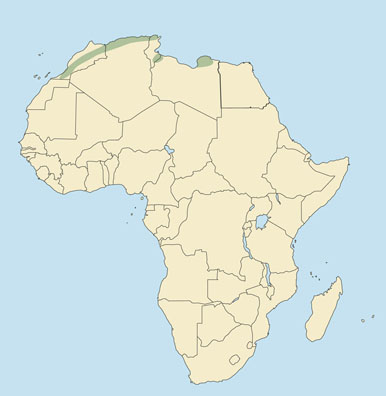 |
Sus scrofa barbarus
Jabalí de Berbería (Sp), Berberwildschwein (G), Sanglier de Barbarie (F). Takes its name from the Barbary region of North Africa. "Barbary" is from the Berber people, who are the chief inhabitants of the region. Sometimes called North African wild boar.
DESCRIPTION Shoulder height 30-35 inches (76-89 cm). Weight 150-250 pounds (68-114 kg).
A thick-bodied animal with relatively thin legs, a short neck, and a long, pointed head ending in a disk-like snout. The coat is coarse and bristly. The general color is a grizzled dark olive brown, turning grayer with age. There are no facial warts. There are scent glands on the face, chin and foot joints. The canine teeth are well-developed, forming tusks. Upper tusks grow outward and backward; the lower ones grow upward and backward, tending to make a circle. The tusks usually wear against each other, honing sharp cutting edges. Females are similar to males but smaller, and have much smaller tusks.
The Barbary wild boar is smaller than the wild boars of Europe and Asia, with a shorter and thinner coat, and possibly a slightly longer snout.
BEHAVIOR Gregarious, living in family groups, though old boars may be solitary. Females generally produce one litter a year, normally in the spring after a gestation period of about 3-1/2 months. The usual litter is 4-8, with a range of 1-12. The piglets are horizontally striped at birth, and are able to run shortly after being born. Sexually mature at 8-10 months, but females usually do not mate until about 18 months. Average lifespan is about 10 years, but may be twice that in captivity.
Mainly active at night and twilight, resting during the day in thick cover or shade. Builds crude shelters of cut grass that it crawls under. An omnivorous feeder, eating all kinds of vegetable matter, also small animals and carrion. May travel great distances in search of food. Requires water for drinking and wallowing. Will wallow in mud for hours if given the opportunity. Sense of smell is very good, hearing is good, but eyesight is only fair. Wary and alert. A fast runner and a strong swimmer.
HABITAT Undergrowth and forest, with nearby water, at any altitude. Also agricultural areas with nearby cover.
DISTRIBUTION Originally across the northern edge of Africa from western Sahara to Egypt. Now restricted to mountain forest and bush in Morocco, northern Algeria and northern Tunisia; possibly may still occur in western Sahara.
|





